|
|
|
|
|
The Simulink® 3D Animation™ product lets you view and interact with dynamic system simulations in a 3-D virtual reality environment. The toolbox links MATLAB® and Simulink® with virtual reality graphics, enabling MATLAB or Simulink to control the position, rotation, and dimensions of the 3-D images defined in the virtual reality environment. The result is a presentation-quality 3-D animation.
Through visualization, the Simulink 3D Animation product provides insight into the dynamic systems that you model in Simulink. You can use these viewing capabilities in automotive, aerospace, communication, biological, and mechanical applications.
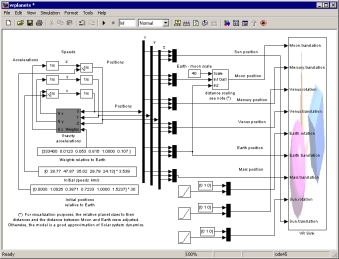
Simulink model of inner Solar system dynamics. Simulink 3D Animation interface block VR Sink sends Simulink signals to the corresponding object values (node fields) in the associated VRML scene.
 Click here to see enlarged view Click here to see enlarged view
Key Features
 Links signals from Simulink to virtual reality worlds to control properties such as the motion of virtual reality objects Links signals from Simulink to virtual reality worlds to control properties such as the motion of virtual reality objects
 Includes tools for viewing and building virtual reality worlds Includes tools for viewing and building virtual reality worlds
 Provides client/server architecture to enable collaboration among multiple locations Provides client/server architecture to enable collaboration among multiple locations
 Produces video recordings for viewing through AVI and WRL file formats Produces video recordings for viewing through AVI and WRL file formats
 Interacts with real-time simulations Interacts with real-time simulations
 Includes MATLAB functions for retrieving and changing virtual world properties Includes MATLAB functions for retrieving and changing virtual world properties
 Connects to common hardware input devices, including joysticks, Magellan SpaceMouse, and Logitech SpaceBall 5000 Connects to common hardware input devices, including joysticks, Magellan SpaceMouse, and Logitech SpaceBall 5000
|
|
|
|
|
|
MATLAB is a high-level technical computing language and interactive environment for algorithm development, data visualization, data analysis, and numerical computation. Using MATLAB, you can solve technical computing problems faster than with traditional programming languages, such as C, C++, and Fortran.
You can use MATLAB in a wide range of applications, including signal and image processing, communications, control design, test and measurement, financial modeling and analysis, and computational biology. Add-on toolboxes (collections of special-purpose MATLAB functions, available separately) extend the MATLAB environment to solve particular classes of problems in these application areas.
MATLAB provides a number of features for documenting and sharing your work. You can integrate your MATLAB code with other languages and applications, and distribute your MATLAB algorithms and applications.
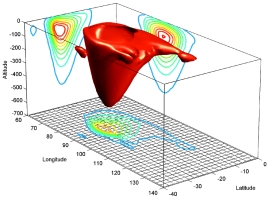
Volume visualization with MATLAB. This plot provides a three-dimensional visualization of a simulation of Jupiterīs Great Red Spot, defined by an outer isothermal surface.
 Click here to see enlarged view Click here to see enlarged view
Key Features
 High-level language for technical computing High-level language for technical computing
 Development environment for managing code, files, and data Development environment for managing code, files, and data
 Interactive tools for iterative exploration, design, and problem solving Interactive tools for iterative exploration, design, and problem solving
 Mathematical functions for linear algebra, statistics, Fourier analysis, filtering, optimization, and numerical integration Mathematical functions for linear algebra, statistics, Fourier analysis, filtering, optimization, and numerical integration
 2-D and 3-D graphics functions for visualizing data 2-D and 3-D graphics functions for visualizing data
 Tools for building custom graphical user interfaces Tools for building custom graphical user interfaces
 Functions for integrating MATLAB based algorithms with external applications and languages, such as C, C++, Fortran, Functions for integrating MATLAB based algorithms with external applications and languages, such as C, C++, Fortran,
Java, COM, and Microsoft Excel
|
|
|
|
|
|
Simulink is a platform for multidomain simulation and Model-Based Design of dynamic systems. It provides an interactive graphical environment and a customizable set of block libraries that let you accurately design, simulate, implement, and test control, signal processing, communications, and other time-varying systems.
Add-on products extend the Simulink environment with tools for specific modeling and design tasks and for code generation, algorithm implementation, test, and verification.
Simulink is integrated with MATLAB, providing immediate access to an extensive range of tools for algorithm development, data visualization, data analysis and access, and numerical computation.
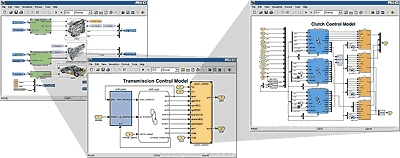
You can construct a model by assembling design components, each of which could be a separate model.
 Click here to see enlarged view Click here to see enlarged view
Key Features
 Extensive and expandable libraries of predefined blocks Extensive and expandable libraries of predefined blocks
 Interactive graphical editor for assembling and managing intuitive block diagrams Interactive graphical editor for assembling and managing intuitive block diagrams
 Ability to manage complex designs by segmenting models into hierarchies of design components Ability to manage complex designs by segmenting models into hierarchies of design components
 Model Explorer to navigate, create, configure, and search all signals, parameters, and properties of your model Model Explorer to navigate, create, configure, and search all signals, parameters, and properties of your model
 Ability to interface with other simulation programs and incorporate hand-written code, including MATLAB algorithms Ability to interface with other simulation programs and incorporate hand-written code, including MATLAB algorithms
 Option to run fixed- or variable-step simulations of time-varying systems interactively or through batch simulation Option to run fixed- or variable-step simulations of time-varying systems interactively or through batch simulation
 Functions for interactively defining inputs and viewing outputs to evaluate model behavior Functions for interactively defining inputs and viewing outputs to evaluate model behavior
 Graphical debugger to examine simulation results and diagnose unexpected behavior in your design Graphical debugger to examine simulation results and diagnose unexpected behavior in your design
 Full access to MATLAB for analyzing and visualizing data, developing graphical user interfaces, and creating model Full access to MATLAB for analyzing and visualizing data, developing graphical user interfaces, and creating model
data and parameters
 Model analysis and diagnostics tools to ensure model consistency and identify modeling errors Model analysis and diagnostics tools to ensure model consistency and identify modeling errors
|
|
|
|
|
|
SimMechanics™ extends Simulink with tools for modeling and simulating mechanical systems.
SimMechanics simulates the motion of mechanical devices and generates mechanical performance measurements associated with this motion. It is integrated with MathWorks control design and code generation products, enabling you to design controllers and test them in real time with the model of the mechanical system.
SimMechanics can be used for a variety of aerospace, defense, and automotive applications, such as the development of active suspension, antirollover, landing gear and control surface actuation systems.
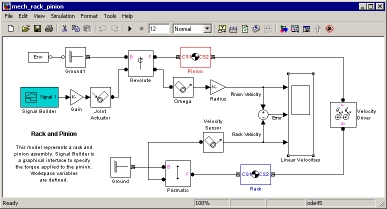
This model represents a rack and pinion assembly built in SimMechanics.
 Click here to see enlarged view Click here to see enlarged view
Key Features
 Provides a modeling environment for building three-dimensional rigid-body mechanical systems Provides a modeling environment for building three-dimensional rigid-body mechanical systems
 Includes a variety of simulation techniques for analyzing motion and sizing mechanical components Includes a variety of simulation techniques for analyzing motion and sizing mechanical components
 Enables the visualization and animation of mechanical system dynamics Enables the visualization and animation of mechanical system dynamics
 Enables the implementation of high-fidelity, nonlinear plant models in Simulink to support the development and testing Enables the implementation of high-fidelity, nonlinear plant models in Simulink to support the development and testing
of control systems
 SimMechanics Link enables the use of CAD tools to define mechanical models SimMechanics Link enables the use of CAD tools to define mechanical models
|
|
|
|
|
|
Stateflow® is an interactive design tool for modeling and simulating event-driven systems. Stateflow provides the language elements required to describe complex logic in a natural, readable, and understandable form. It is tightly integrated with MATLAB and Simulink, providing an efficient environment for designing embedded systems that contain control, supervisory, or mode logic.
Stateflow charts enable the graphical representation of hierarchical and parallel states and the event-driven transitions between them. Stateflow augments traditional statecharts with the innovative capabilities of control flow, MATLAB and graphical functions, truth tables, temporal operators, directed-event broadcasting, and support for integrating hand-written C code.
You can automatically generate C code from Stateflow charts using Stateflow Coder (available separately).
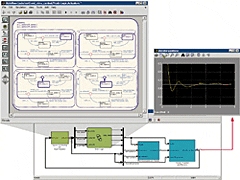
The fault detection, isolation, and recovery system of an aircraft elevator. You can use Simulink and Stateflow to simulate and study the effects of switching modes on the control system and aircraft dynamics.
 Click here to see enlarged view Click here to see enlarged view
Key Features
 Provides language elements, hierarchy, parallelism, and deterministic execution semantics for describing complex logic Provides language elements, hierarchy, parallelism, and deterministic execution semantics for describing complex logic
in a natural and understandable form
 Defines functions graphically, using flow diagrams; procedurally, using the MATLAB language; and in tabular form, Defines functions graphically, using flow diagrams; procedurally, using the MATLAB language; and in tabular form,
with truth tables
 Schedules transitions and events using temporal operators Schedules transitions and events using temporal operators
 Incorporates custom and legacy C code with input and output arguments Incorporates custom and legacy C code with input and output arguments
 Supports vector, matrix, and fixed-point data types Supports vector, matrix, and fixed-point data types
 Provides viewing and logging of states and data Provides viewing and logging of states and data
 Animates Stateflow charts to enhance understanding of the system and facilitate debugging Animates Stateflow charts to enhance understanding of the system and facilitate debugging
 Performs static checks, including checks for ill-specified truth tables Performs static checks, including checks for ill-specified truth tables
 Performs run-time checks for transition conflicts, cyclic problems, state inconsistencies, data-range violations, Performs run-time checks for transition conflicts, cyclic problems, state inconsistencies, data-range violations,
and overflow conditions
 Includes an integrated debugger for setting graphical breakpoints, stepping through models, and browsing data Includes an integrated debugger for setting graphical breakpoints, stepping through models, and browsing data
|
|
|
|
|
|






